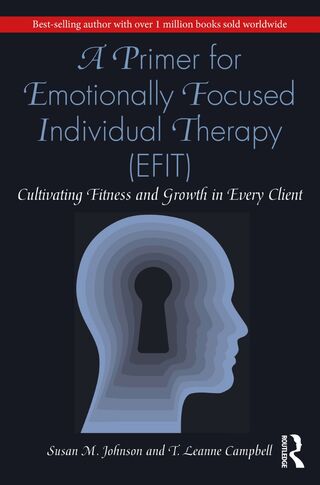Attachment
A Primer for Emotionally Focused Individual Therapy
The Book Brigade talks to psychotherapists Sue Johnson and Leanne Campbell.
Posted September 23, 2021 Reviewed by Lybi Ma

What are the basics of emotionally focused therapy?
Emotionally Focused Therapy privileges emotion and emotion regulation, shaping key emotional experiences in session, where the therapist guides clients into and through the emotional moments that define their sense of self and of others towards a new sense of balance competence and connection. It is profoundly relational and offers attachment science, with its map to human longings, misery, and motives, as a way to focus each session and create on-target interventions. EFT is the gold standard of couple intervention, with a large body of research supporting its efficacy and long-term effects. Over the last few years, the use of EFT with individuals (EFIT) dealing with depression, anxiety, and PTSD have been further outlined and refined. This model is now set out in the new primer.
How does EFIT capitalize on the science of attachment?
Attachment offers a map to blocked developmental pathways obscuring secure, coherent connection with a resilient sense of self and with others. As a developmental theory, it also offers a clear model of personality and relational health and what is needed to reach this goal. The attachment map guides the therapist in the attunement process and offers a compass in the growth process.
The therapist also creates a specific kind of alliance—a safe haven and a secure base for growth in every session and addresses “frightening, alien, and unacceptable” emotions and emotional dilemmas. From an attachment viewpoint, negative emotions and coping strategies keep clients stuck in recurring and negative self-perpetuating cycles of arousal and interactions with others.
Emotional isolation is seen as a core issue and risk factor for all mental health issues. Just as being able to be open, present, and responsive to inner cues and to others creates corrective encounters in couple therapy, so, in EFIT, do such encounters with the self and representations of key attachment figures or aspects of self. The attachment frame helps the therapist sing to the client’s amygdala in a way that shapes an organic, already wired-in growth process.
Attachment helps me formulate how Pat’s terror of abandonment fuels her obsessive planning and guardedness in relationships and primes her sense of inadequacy. Her eating disorder numbs her out but the emotional music she dances to leaves her more and more alone and desperate. It also helps me assemble her emotions into an ordered whole that she can tolerate and own and then move into comforting restructuring encounters with her vulnerable self and her distant, unavailable mother. She tells me, “This is different, hard. But it’s exhilarating to have myself more solid. And I can share with my friend Amy now so I am less alone and overwhelmed.”
To what degree does early experience drive adult experience?
It is in our younger years that we learn how to approach and regulate our core emotions and that our sense of self and habitual ways of connecting with others take shape. First lessons are powerful and embodied in the nervous system, affecting how we navigate our world and continue to form our identity. But they are not cast in stone. Positive connections with supportive attachment figures can help us deal with trauma and deprivation and still find a way to be resilient. Our secure connection with our inner resourceful self and with others can change and grow throughout our adult life. Indeed, EFT research has shown that this therapy can create more secure attachment styles and more securely bonded relationships that reduce factors like depression and help build resilience and strength. A brain scan study found that EFT for couples and the bonding events that occur in that therapy change the way women’s brains respond to a physical threat (click here for a list of studies).
How does this therapy differ from other types?
General EFT and EFIT are explicitly based on attachment science. EFT combines a focus on dancer and dance – how the individual shapes their own reality and their relationships with others. EFT has been rigorously tested empirically in terms of outcomes, follow-up effects, and exactly what creates a significant change in session.
It focuses on emotion and uses the power of restructured emotion to move clients into potent new experiences that expand the self and prime new cognitions and action tendencies. Interventions, such as the five moves of the EFT Tango, are well-articulated and are taught across cultures around the globe. Training receives the highest ratings in terms of expanding practice and therapist confidence.
In general, EFT combines the clarity and focus typical of more behavioral interventions with the depth and relevance of more humanistic experiential therapies, allowing people to address deep existential fears and longings.
How does EFT, EFIT work for individuals as opposed to couples?
The theoretical frame and the core interventions are the same across modalities. However, the primary goal in EFIT is the expansion of the self rather than the shaping of more positive bonding connections with specific others in-session.
One core difference between EFT for couples and families and EFIT can be seen in Tango Move 3—where newly discovered and formulated emotion is enacted in encounters with parts of self and imaginal others. In couple therapy, Sarah is encouraged to turn to her partner John and share her vulnerability and need in a way that pulls him close and helps him respond as a safe attachment figure. In EFIT, Pat allows herself to experience her overwhelmed terrified self who could not ask her mother for comfort in the dark and deal with rejection but can in session comfort this vulnerable self and validate the pain and legitimacy of this self. Pat brings alive key representations of self and also of attachment figures such as her mother and changes the dance with them. As she allows herself to feel loss and aloneness, she finds her anger and is able to confront her mother in an imagined encounter. Core ways of seeing herself, dealing with emotions, and engaging with others then start to shift.
How do you use an emotional charge to turn around a client’s life?
In the five moves of the EFT and EFIT Tango, you evoke the emotions that underlie dysfunctional patterns in the client’s life and help order and validate them. They then become tolerable and manageable and can be owned and explored on a deeper level.
Emotion colors perception, shapes meanings, primes body responses, and moves people to action. It also communicates to self and others the nature of a person’s felt reality. These are all dynamic processes. Across therapy modalities, deeper emotion has been shown to lead to change. When Henny truly lets in and outlines her first rape by her father she is able, with the therapists' help, to order this experience and follow it through to the beginning of closure. She comforts her devastated 6-year-old self and helps her listen to a new set of meanings and images of self. Her overwhelming experience is of deep grief and aloneness. As she grieves, she finds compassion and respect for herself and a new determination to find connection. She tells me in the next session, “Now I have me so I can deal with that scene and not feel so devastated.”
I would ask, as an EFT therapist, what else but an emotional charge ever really turns around someone’s life? How we deal with our vulnerability structures so much of our reality—to encounter it in safety, enter it, and reformulate it is what change is all about.
Why does the word “safe’ have such prominence in EFT?
In thousands of studies, attachment science outlines how secure connection with others offers us the sense of safety we need to grow, risk, develop, and explore our world. Vigilance for danger, avoidance of risk, and a sense of helplessness are key risk factors for all mental health problems. The therapist offers the same kind of safety as a supportive attachment figure, and this naturally calms the nervous system and encourages openness to experience and the courage to fully encounter it. Safety does not mean mouthing nice supportive phrases. It means being fully present to the client and giving the message that this client is seen and accepted in all their frailty and that the therapist believes in their ability to grow and knows how to encourage that growth. People do not turn to and deal with their dragons alone or when they have no safe place to stand. We are not wired for that.
What is the magic in therapy and how do you bring it about?
Magic in EFT is not the sleight of hand of the clever therapist—the insight offered or the clever advice given. Our need for others and the vulnerability of our young have structured our brain and our nervous system to give priority to and respond to certain cues—cues that are saturated in emotion. The magic of EFT is that we know how to go to the heart of the matter with clients, how to engage and enthrall them, and how to plug into, order, and reshape their pain, fear, and longings.
We don’t have to “bring it about.” We follow the natural process of the safe, healthy organism— one who knows that if they call, someone will come and that they matter to others. We remove blocks to the client’s awareness that constrict the magic of growth. I do not persuade Pat that her ideas about herself are misguided or give her exercises in how to be with others or teach her about her brain. I reflect back a hurting but valid and normal sense of self for her to see, and I walk with her into her most frightening places, helping her to find her more whole and coherent. That is magic and it naturally brings joy. The magic is the same as the “magic” in a mother’s touch—in a lullaby or in a reunion with a loved one.
The “magic” of EFT is not just hearsay either; we can show it on tape, rate it, and show that it leads to specific kinds of change such as less depression.
How is it not the content of problems but how we engage with them that matters?
This refers to the focus of EFT therapists on process rather than content. We do not try to solve the client’s problems, to offer quick or immediate solutions. We explore the how, the process of how a symptom is primed, maintained, and perpetuated. Move 1 of the EFT Tango is the reflection of processes that leave the client stuck in pain and helplessness. Pat’s problem is that she is anorexic and she now “manages” her eating better, but she is still miserable and feels alone and depressed. We explore the last time she felt this way and how she anticipates rejection from others, plans every moment of interaction, becomes overwhelmed, tells herself she is a failure, and withdraws. She then eats less to numb out. Once she grasps the emotional music that structures this dance, then she can see how she is trapped and how she traps herself. In Move 2 of the Tango, we assemble her emotion piece by piece, and she discovers the 6-year-old self who was always left alone in the dark. Once she assembles her emotional reality in a new way, new responses naturally open up. An action tendency is implicit in all emotion; emotion literally moves us. She also tells her best friend about this “dance,” and her friend normalizes and validates it. She is already less alone.
Are people looking to solve the wrong problems or in the wrong way?
Pat’s therapist “solved” her eating problem, but Pat reported that this therapist did not want to go into her anxiety and fearfulness! Pat “solved” her problems by ruminating, planning every move, worrying, and shutting down. If you do not have a model of human development to guide you, then you are almost bound to get distracted and go down the rabbit hole in therapy. Clients bring complex stories and issues; a compass is needed.
What is one insight or idea would you like readers to get from this book?
I would like therapists to know that attachment science and a focus on priming and ordering core emotions is the way forward for psychotherapy. We already can integrate science and practice; we already know so much.
About THE AUTHOR SPEAKS: Selected authors, in their own words, reveal the story behind the story. Authors are featured thanks to promotional placement by their publishing houses.
To purchase this book, visit: A Primer for Emotionally Focused Individual Therapy





